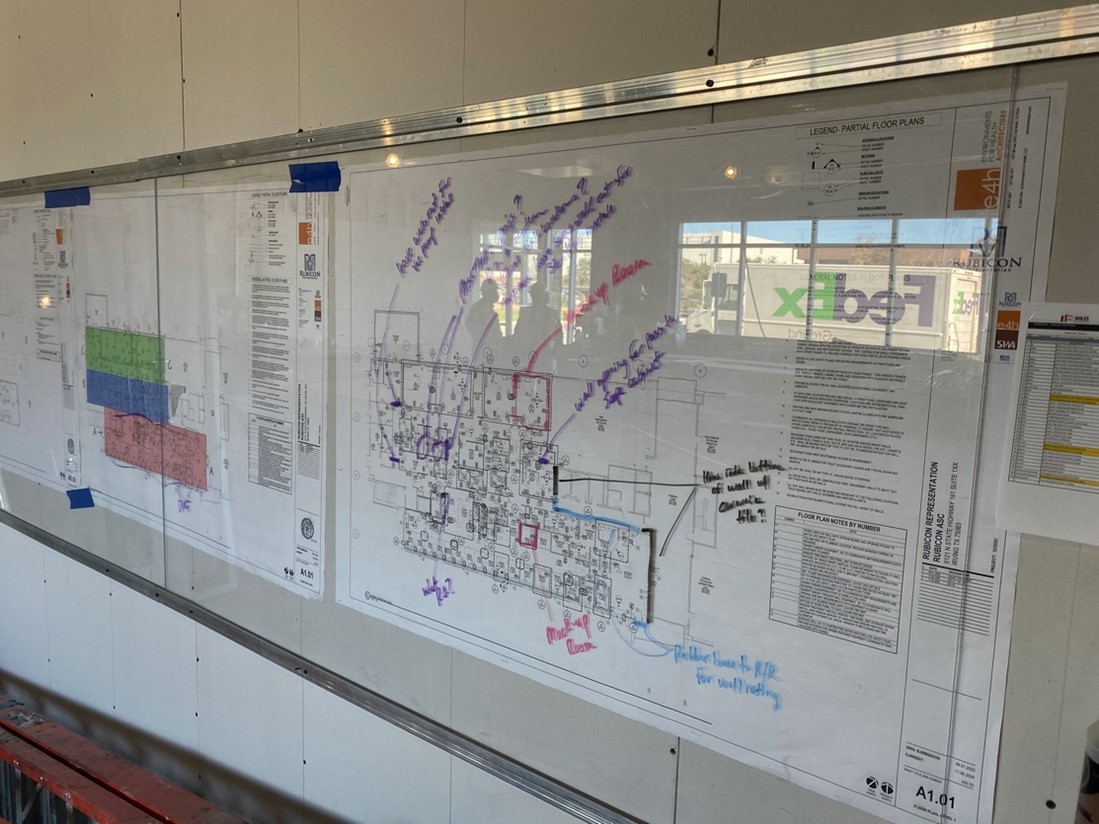Lean Implementation – As field-focused Lean practitioners, Joe and I are often asked for our thoughts around the most effective way to implement Lean methodologies on a construction project. Here’s a quick “how-to,” outlining the benefits of Lean Construction tools and processes, with an emphasis on their practical application to improve communication and workflow.
Make it Stick: Four Steps for Implementing Builder’s Lean
Step One: Move to a Daily Huddle
Are your subcontractor/field coordination meetings unproductive? Do the foremen seem disengaged? Do topics take too long to work through? Consider switching to a daily huddle, as well as these practices:
- Set a Timer — A huddle should last no longer than 15 to 20 minutes. If you go longer than that, you risk losing the attention and engagement of the participants.
- Start and End on Time — Punctuality makes a good first impression, fosters productivity, establishes routine, builds trust and shows you value everyone’s time.
- Phones Off — Everyone should be present. Allowing participants to use their phones shows a lack of respect by implying that whatever is on the device is more important than the people and the conversation in the room.
- No Chairs — Keep everyone standing. This helps maintain focus on the discussion at hand.
- Two-Minute Rule/Parking Lot — If an issue has been discussed for more than two minutes, it should be set aside and resolved later. Put this topic in the “parking lot” for a discussion following the huddle with only the people who need to be involved, as opposed to the entire team.
Step Two: Employ Visual Communication Tools
Visual communication tools play a very important role in establishing and maintaining reliable workflow in the field. When communication breaks down, teams experience loss of productivity, hindered completion times and costly errors. Visual communication tools significantly help bridge communication gaps and facilitate better trade-to-trade collaboration at the morning huddle.
Purchase clear laminate and a pack of colorful dry erase markers, and then designate a different color per trade. Mount your floor plans and elevations under the laminate on a wall, and have the trade partners both verbally and visually show the team the following items during the daily huddle:
- what they are working on;
- where they are working;
- how many crews/workers they have on-site;
- where constraints are; and
- what material deliveries are scheduled.
Make sure that your visual tools are easy to set up, see, update/maintain, use and understand.
Step Three: Managing Constraints
If you find it difficult to understand, organize and resolve issues in an effective or timely manner, a constraint board can help. This powerful tool helps the team communicate, prioritize and track the constraints that invariably arise during construction. If you’d like to implement a constraint board, all you need is dedicated whiteboard space or a large sheet of paper. Create a chart with the following four columns:
- WHAT?
- WHO?
- WHERE?
- WHEN?
“WHAT” refers to what is the constraint, while “WHERE” asks where it is occurring. When a trade partner brings up a new constraint in the daily huddle, it’s important to not get too deep in the details. The huddles are fast-paced, and a lot of time can be spent in describing a constraint and its implications. It is best to just quickly capture WHAT and WHERE, and then move on.
As for “WHO,” it asks who is responsible for getting a solution, and “WHEN” refers to when do they commit to having it complete. The WHO and WHEN columns must be filled out at the huddle with the trade partners. This is the commitment portion of the constraint board: assigning responsibility to someone and making a promise about when it will be resolved. This practice adds strong layers of accountability to the team.
At the daily huddle, ask your team to write their constraints on the board. This allows the trade partner with the constraint to feel heard, and serves to shift the project’s culture into one where the trades collaborate and resolve their issues together, rather than making the superintendent the middleman.
Removing Constraints
Only the person who initiated the constraint should be allowed to remove it. This allows the initiator to maintain ownership and prevents it from being removed by someone who may not have all the necessary information.
This constraint process will be tough for some team members to acclimate to, as many are not used to this level of transparency or accountability. Use empathy with your team when challenges or conflicts are raised, as those individuals are often in an overextended state.
Build the Project Culture
At the heart of the Lean philosophy is respect for the individual, and this is what sets great teams apart. Strive to build an environment where people are accepted as they are, and the focus is on solving the root causes of challenges or constraints instead of on the noise that surrounds them.
Step Four: The Last Planner System
Once you’ve established a strong daily huddle routine and your team is effectively using visual communication tools and a constraint board, it might be time to move on to the Last Planner System as your fourth step in Lean implementation. The beauty of the Last Planner System is that it allows the field leaders closest to the work to plan the work. It’s holistic, and all facets of it must be utilized to leverage its maximum potential.
The Last Planner System is better served as the topic of a separate article, since so much is involved. I’d encourage you to visit some of our posts on the subject and visit the Lean Construction Institute online at www.LeanConstruction.org to learn more about Lean concepts, tools and processes like the Last Planner System, and to find an LCI Community of Practice near you.
Lean concepts are simple, but implementation is not easy. You will fail a time or two, trade foremen will push back — and when things on your project get tough, it will be tempting to return to what’s familiar. Be open-minded and willing to explore these new ideas and concepts, which may push you to abandon the comfort zone that is “that’s the way we have always done it.”











